Loose slot threads when weaving on a rigid heddle loom are very common. The fact is that a rigid heddle loom just does not hold the same amount of tension as a floor or table loom.
This means that the rigid heddle weaver can run into a bit of bother when warping up with fine, rigid weaving yarns. An 8/2 cotton is a floor loom weaver’s dream but can be quite a challenge on the rigid heddle.
*This post contains affiliate links. For further information, please view my disclosure policy.
Knitting yarns or slightly thicker weaving yarns with some elasticity work beautifully on a rigid heddle loom, as they don’t need a lot of tension and are very forgiving.
How do I know if my tension is good enough?
This can be a personal preference, but there are certainly a few guidelines for knowing whether your tension is suitable or not:
Too loose
Your warp threads bunch in between weft picks (rows)
You have floats or skipped warp threads often
Your stick shuttle keeps snagging on warp threads as you enter the sheds
Your heddle doesn’t click easily into the up or down shed
Too tight
You struggle to get your heddle/s into the up position
You have warp threads breaking
You feel a lot of resistance when trying to beat
Does this mean that rigid heddle weavers should not weave with weaving yarns? Not at all! There are too many wonderful weaving yarns in a massive variety of colours out there to try! With the right approach and strategies, all yarns can be used successfully.
- Getting the warp right
The warping the loom stage is the most crucial time to get that tension as good as you can. Not as tight as you can, necessarily, but even, consistent and firm. When I have a good warping experience, I just know that the project is going to go smoothly.
There are a few key strategies for getting good tension during the warping process. I talk about it in this webinar but I also want to mention some of them here:
- Have someone help you. Your helper can hold on to the end of the warp, providing great tension, while you focus on standing behind the loom and winding on.
- Pack the back beam as you roll on. You can use cardboard or wooden sticks/ separators, a roll of thick paper, a blind or a drawer liner. My personal favourite here is the roll of paper which you can cut to size if needed. 125 gsm is a good weight.
- For a wider warp, use more than one warping peg. This helps distribute the threads over the width of the loom in a more practical way and is more economical, as threads don’t have to travel as far to loop around just one peg.
- Take your time. Extra time spent in warping is well worth the investment. Remember – good warp = happy weaving experience 😄
- Pay particular attention to the middle of the warp while rolling on, particularly if warping independently. The middle is the most likely place to lose tension and get saggy threads.
2. Consider a shorter warp
A rigid heddle loom can take quite a lot of length in a warp, but I haven’t found a long warp to be best practice. If I have the opportunity, I will break a warp into smaller increments where possible.
This doesn’t bother me, because the rigid heddle is so quick to warp for more simple projects, so it doesn’t take much extra time. I find that the longer my warp on the rigid heddle, the harder it is to keep a good tension for the duration of the warp.
3. The tie on
The tying on step is also important for your overall tension. Whether you tie directly on to the apron rod (as I do 99% of the time) or lash on, this step is another opportunity to “get it right” before beginning weaving.
Once again, I don’t aim for really tight tension when tying on, but I do aim for the best consistency I can manage. This means going over the tied on threads once, twice, thrice if needed so that they all feel about the same.
I gauge this tension by bouncing my hand across the warp (like a trampoline!) Any bunch of threads that feel much looser than others will get a re-tighten.
4. Know your yarns
There are certain threads that are harder to tension due to their inelastic structure. I already mentioned 8/2 cotton, but many plant based or cellulose fibres (cotton, linen, hemp, etc) are quite rigid and easier to weave with a higher level of tension. Animal fibres or protein fibres (wool, alpaca, etc) generally have a little more stretch.
There are certain threads that are harder to tension due to their inelastic structure. I already mentioned 8/2 cotton, but many plant based or cellulose fibres (cotton, linen, hemp, etc) are quite rigid and easier to weave with a higher level of tension. Animal fibres or protein fibres (wool, alpaca, etc) generally have a little more stretch.
The amount of twist, number of ply and thickness or weight can also effect how rigid a yarn is. It helps to know your yarns – to sample yarns you’r unsure of and accustom yourself to all their particulars.
If you need a little more guidance with yarns, I have some resources that will help:
Choosing and using yarns in weaving
What is a superwash wool yarn?
3 yarns beginner weavers should never use!
5. Stuff it!
Packing, stuffing and wedging your back and front beams will always help with tension. If, despite your best efforts, your warp is just not tensioned well enough then start packing! You can use stiff paper, cardboard, sticks (either separators or pick up sticks) or whatever else you can come up with that works, to wedge under or between your warp at the beams.
When advancing your warp, start packing the front beam. This will prevent the knots from the apron rod from sticking into your weaving as it rolls around them beam (which can damage or distort your weaving and mess with your tension) and provide overall better tension each time you advance.
You can insert a pick up stick or something similar into a shed that is giving you particular trouble (usually the down shed) and slide it to the back beam. Push it right back so that it becomes wedged between the thread layers and tightens that shed for you.
You can also wedge something directly under the warp at the back beam to increase overall tension. To see this in action, watch this video, which also includes additional tips for working with fine threads:
6. One sided looseness
Perhaps your loose tension problem is at the selvedge? To be more specific, one selvedge is fine while the other is loose? You end up with neat edges on one side and not so great edges on the opposite side.
If you want generally to improve the neatness of your edges, check out this post for more resources.
One thing you can try in this instance is to begin and finish threading in a hole. When we thread for plain weave, we usually thread one thread in a hole, one in a slot, and so on. Most of the time we are threading an even number of threads.
But for this technique, we thread an uneven number of ends on purpose, so that the last thread gets threaded through a hole. The reasoning behind this technique is twofold. Firstly, the threads are threaded in holes, which hold better tension than the slots. Secondly, the outermost threads will be under the same or similar tension (both being in holes) so the results of your woven edges should be more similar looking.
If that sounds confusing, check out this video where I show you how to thread both selvedge threads in holes and you will see how simple it is:
7. Warping in down shed
As a disclaimer, I have not tried this technique, I have only heard about it. The idea is that it’s the down (slot) sheds that have looser tension, so warping your loom with the heddle in the down shed potentially tightens the slot thread tension. If you decide to give this a go, I would be interested to know how it turns out for you!
I hope this article was useful to you. As always, questions and comments are welcome, please leave them down below! ⤵
Until next time…
Happy Weaving!

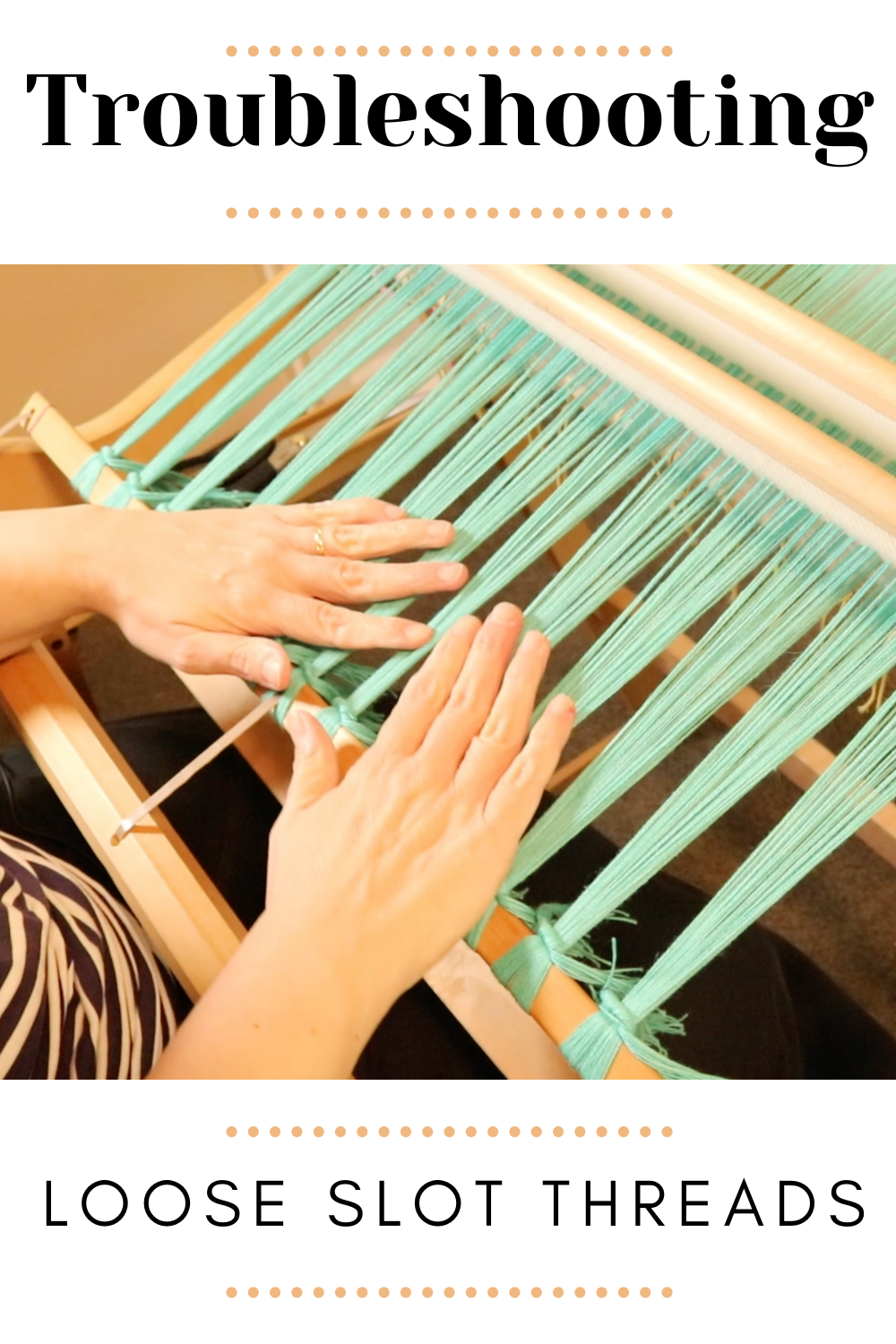
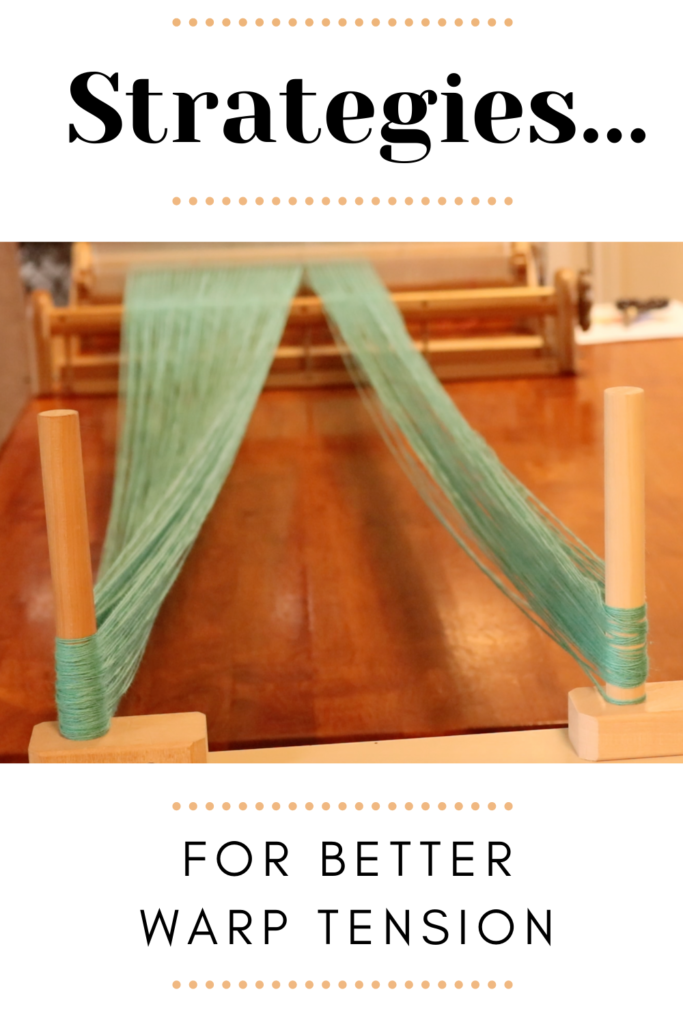
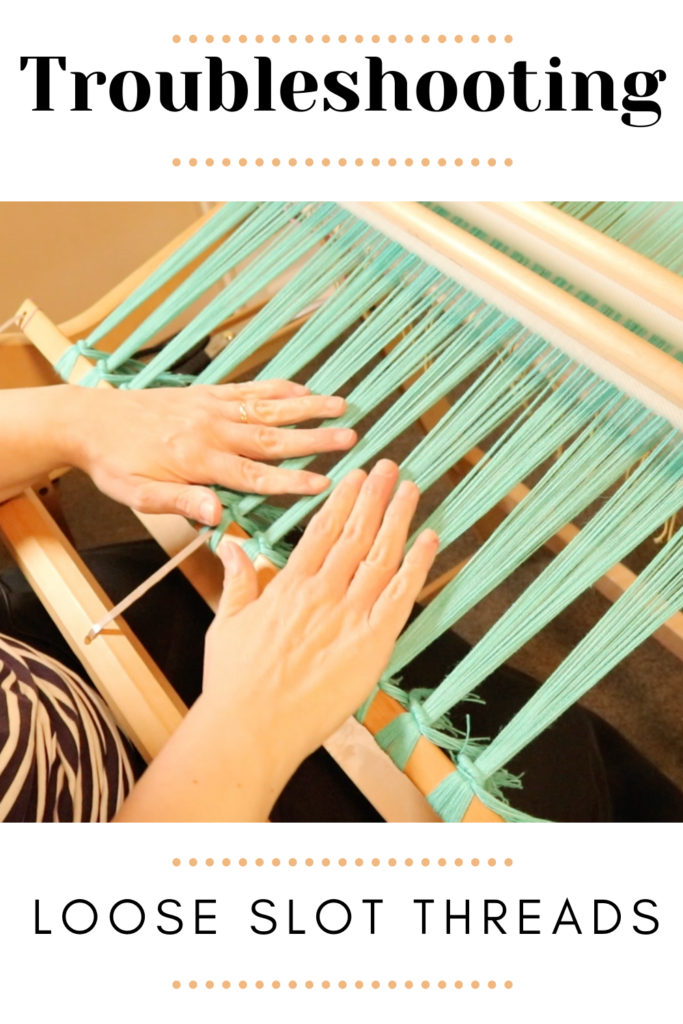
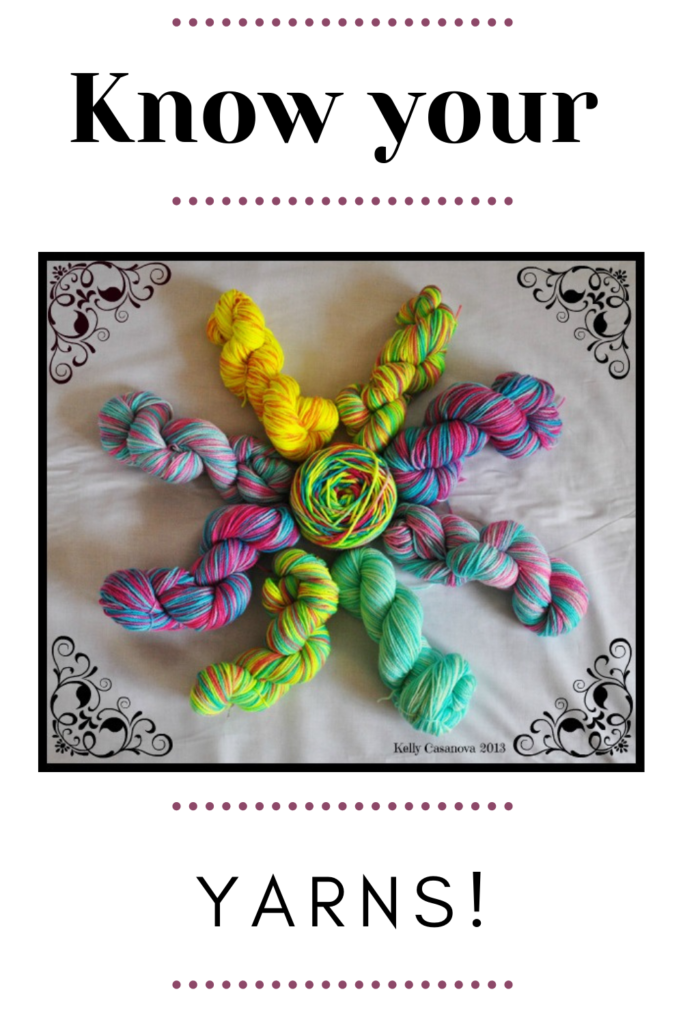
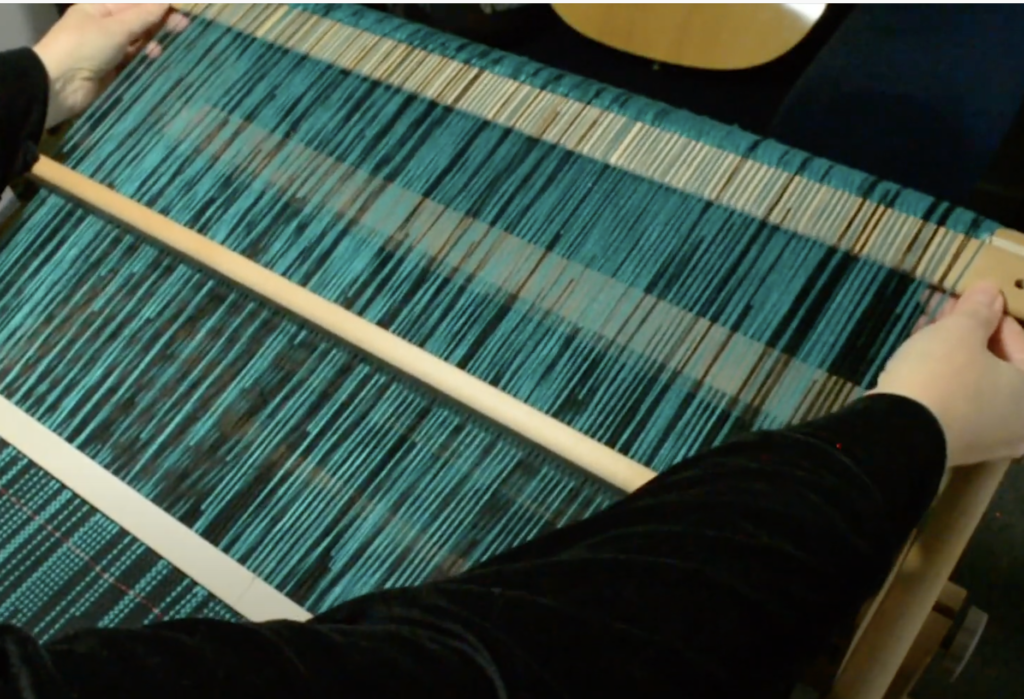
Hi Kelly,
I have mistakenly put two loops through one slot and I didn’t notice and have wound all the yarn onto the back beam and am now putting the ends through the eyes but I have a redundant pair of threads in one slot. Can
you suggest what I should do please?
Diana
Hi Diana, I’ve just seen your comment on the weaving school and have answered there 😉
I’m weaving simple dish towels at the moment on my new Ashford 24″.I’ve not had issues with tensioning on my Cricket loom, so this was a surprise. For the first towel, the tension was perfect, but by the second, the whole center had become loose. Now I think I have practically a whole cereal box of strips across the back along with some sticks trying to keep it under control. I’m really going to try that down shed method to see if that helps.
This was a great tutorial. Thank you so much Kelly. I learned a lot.
Wonderful, thank you Diane!
I am a multi-shaft weaver that liked the simplicity and portability of the RH loom. I learned a lot from this tutorial. THANK YOU
Wonderful, thank you!
Thank you for this very informative post! I love to weave with 8/2 cotton but have had so many problems with loose threads I had kind of given up. Now I have some new strategies to try!
Thank you for this great article…lots of useful information. I love to weave with 8/2 cotton but have had problems with loose threads. I’m definitely going to try my next warp in the down shed. For some reason, my selvedge threads are always extremely tight. In fact, a selvedge thread broke on my last warp and I had so many hanging threads I abandoned it after weaving about 10 inches. Very frustrating!
That is such a common problem, which is why I specifically referred to the middle of the warp when winding your warp on – it’s so easy to get tight selvedge threads and loose middle threads! I would be interested to know whether the down shed warping is helpful to you 😊
All of your articles are helpful. I appreciate your helping us with video’s and your newsletter….
You’re most welcome!
I always tie my watps with the sheds open. Because of the structure of the rigid heddle room, the slot thread is always travel a shorter distance than the hole thread. So if you tie up in neutral position it will always be looser. It works great for me.
So well put and helpful. Thank you!
next project will do the final thread in the hole rather than the slot. Thanks for the tip. Michele
I almost always warp in a down shed on my rigid heddle. Works like a charm. Have seldom had problems since I started using this approach despite lots of weaving with 8/2 cotton and cottolin.
Great!
Thanks, Kelly!
I’ve tried the down-shed method a couple of times and it’s made a huge difference for me. I went from having a LOT of tension problems to having none.
Interesting!
Thank you Kelly! I just experienced this, the last two projects I did were with 8/2. First time with that thread so I did struggle a bit with the overall tension. One project it was toward the end and one project it was from the very beginning. The S hooks were out! I hadn’t thought of putting cardboard into the shed as I go, so thank you for that! Also the end threads in slots is what I’ll try next time as well. In your example, could you have taken that end thread and just put it into a hole instead of discarding it? Thank you as always for all your help!
Do you mean put it into the next hole? Then I would have to skip a slot?
When I first learned to warp my loom I learned to warp it in the down shed. I usually have very little problem with loose threads. I have never tried warping in the neutral position. Might just give that a go to see the difference. Glad you mentioned this.
I’d love to try this, but I’m confused how you tie on in the down position. I have an Ashford Knitters Loom. While there is an actual down position, it works because of the tension in the tied on yarn. How do you tie it on in that position?
I haven’t tried it myself, I imagine you would start tying some bundles on then place the heddle down and tighten the bundles up once you have tied on enough to sustain a down position with the heddle.
Makes sense. I should’ve thought of that 😉. Thanks for the response, Kelly!
i have used a Beka RH loom since 1991. When tying on the warp you must put the heddle in the up position or the tension will be off – always. I’m not sure about any other loom. Thanks for you time and teaching. Merry Christmas!
Yes, the Beka looms are a bit different to other rigid heddle looms 😊
Very helpful article – thank you! I panicked a little at first when you seemed to suggest that a RH was not suitable for finer, inelastic threads since that is one of my areas of interest. It was a great relief to see that there are practical methods to address those tension issues. I don’t yet have my loom, but the last technique (warping in the down shed) sounds like something I’d like to try.
That’s the great thing about a rigid heddle – although it is a simple loom there is always a way to do what you want to do with it 😊
As usual, extremely helpful and full of resources!
Thank you SO SO much Kelly!
Elsa
🥰 Thank you for reading!